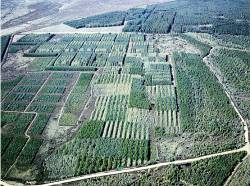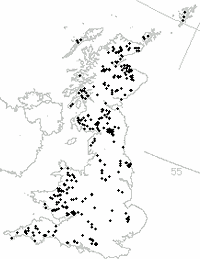Summary
Summary
The aim of the Long-term Experiments (LTE) project is to conserve the best silviculture and genetics field experiments as a strategic resource that can be re-examined to address future important questions about sustainable forest management.
We aim to promote the experiment holding and improve accessibility, enabling multidisciplinary and collaborative research groups to utilise the resource.
Research objectives
- Maintenance of the network of field experiment sites and data records.
- Raising awareness of the resource among stakeholders.
- Enabling research with collaborating scientists, universities and other organisations.
- Advancing long-term forest science in a wide range of silvicultural and ecological fields.
Background

From its establishment in the early 20th century, the Forestry Commission has carried out extensive programmes of research to identify and overcome factors limiting afforestation in various parts of Great Britain, improve management practices, and develop improved genetic material. Many experiments that were established to last the full rotation of the crop still exist, while many others with a shorter planned lifespan also survive and are sufficiently robust in terms of layout and design for longer term studies.
It has become clear that long-term experiments are a valuable resource for addressing unanticipated questions that may be unrelated to the original reason for planting. For example, trials comparing genetic variation within and between species are particularly important for planning silviculture under future climate scenarios. Long-term impacts of different silvicultural techniques on the environment or on biodiversity can also be examined.
Current long-term experimental holding

The Long-term Experiment network currently consists of around 320 experiments with a broad geographical coverage, and including topics such as species mixtures, nutrition, ground preparation, stability and exposure, timber quality, spacing, thinning, native woodlands and natural regeneration. In addition, there are many species and provenance trials on a wide range of coniferous and broadleaved species.
Many experiments are replicated on contrasting site types around Britain, and can be used to study the effects of local conditions on different treatments.
Recent Publications
Mason, W.L. and Connolly, T. (2020) What influences the long-term development of mixtures in British forests? Forestry, DOI: 10.1093/forestry/cpaa093
Ennos, R., Cottrell, J., O’Brien, D., Hall, J., and Mason, B. (2020) Species diversification – which species should we use? Quarterly Journal of Forestry, 114: 33-41.
Willoughby, I.H. and Peace, S. (2019). Delivering Resilient Forests: A summary of research. Quarterly Journal of Forestry, 113 (3), 178–183.
Stokes, V., Lee, S., Forster, J. and Fletcher, A. (2018) A comparison of Sitka spruce x white spruce hybrid families as an alternative to pure Sitka spruce plantations in upland Britain. Forestry, 91(5): 650-661.
Jactel, H., Gritti, E.S., Drossler, L., Forrester, D.I., Mason, W.L., Morin, X., Pretzsch, H. and Castagneyrol, B. (2018) Positive biodiversity–productivity relationships in forests: climate matters. Biological Letters, 14: 20170747. http://dx.doi.org/10.1098/rsbl.2017.0747
Davis, K.T., Callaway, R.M., Fajardo, A., Pauchard, A., Nuñez, M.A., Brooker, R.W., Maxwell, B.D., Dimarco, R.D., Peltzer, D.A., Mason, B., Ruotsalainen, S., McIntosh, A.C.S., Pakeman, R.J., Smith, A.L. and Gundale, M.J. (2018) Severity of impacts of an introduced species corresponds with regional eco-evolutionary experience. Ecography, 42: 1–11.
Drossler, L., Agestam, E., Bielak, K., Dudzinska, M., Koricheva, J., Liziniewicz, M., Lof, M., Mason, B., Pretzsch, H., Valkonen, S., and Wellhausen, K. (2018) Over- and Under-yielding in Time and Space in Experiments with Mixed Stands of Scots Pine and Norway Spruce. Forests, 9, 495: doi:10.3390/f9080495
Kerr, G., Forster, J. and Coventry, R. (2018) Survival and growth of interior spruce in Britain. Scottish Forestry, 72 (3): 22-29.
Kerr, G. and Forster, J. (2018). Can we grow oak to 60 cm DBH in less than 100 years in Britain? Quarterly Journal of Forestry 112(3), 156–162
Mason, W.L. and Connolly, T. (2018) Nursing mixtures can enhance long-term productivity of Sitka spruce (Picea sitchensis (Bong.) Carr) on nutrient-poor soils. Forestry, 92(2): 165-176.
Mason, B., Jinks, R., Savill, P. and Wilson, S.McG. (2018) Species profile: Southern beeches (Nothofagus species). Quarterly Journal of Forestry, 112(1): 30-43.
Savill, P., Stokes, V., Jinks, R., Mason, W.L. and Wilson, S.McG. (2018) Hybrid poplars and aspens. Quarterly Journal of Forestry, 112: 237-248.
Wilson, S. McG., Mason, W.L., Savill, P., and Jinks, R. (2018) Non-native alder species (Alnus ssp.). Quarterly Journal of Forestry, 112: 163-174.
Savill, P., Wilson, S.McG., Mason, W., Jinks, R. and Stokes, V. (2017) Alternative spruces to Sitka and Norway Part 1 – Serbian spruce (Picea omorika). Quarterly Journal of Forestry, 111: 32-39.
Savill, P., Wilson, S.McG., Mason, B., Jinks, R., Stokes, V. and Christian, T. (2017) Alternative spruces to Sitka and Norway, Part 2: Oriental or Caucasian spruce (Picea orientalis), and the American and Asian spruces. Quarterly Journal of Forestry, 111(2): 88-97.
Kerr, G., Stokes, V., Peace, A., Fletcher, A., Samuel, S., Mackintosh, H. and Mason, W.L. (2016) No seed zone effects on the survival, growth, and stem form of Pacific silver fir (Abies amabilis) in Britain. Canadian Journal of Forest Research, 46:427-436.
Mason, B. and Connolly, T. (2016) Long-term development of experimental mixtures of Scots pine (Pinus sylvestris L.) and silver birch (Betula pendula Roth.) in northern Britain. Annals of Silvicultural Research, 40(1): 11-18.
Gundale, M. J. et al. (2016) Differences in endophyte communities of introduced trees depend on the phylogenetic relatedness of the receiving forest. Journal of Ecology, 104: 1219–1232.
Wilkinson, M., Eaton, E.L. and Morison, J.I.L. (2016) Variation in the date of budburst in Quercus robur and Q. petraea across a range of provenances grown in Southern England. European Journal of Forest Research, 136: 1-12.
Stokes, V and Martin, S (2016) Taking the long-view: using past research experiments to guide future forestry. Forestry and Timber News, February 2016, 12-13.
Broome, A., Summers, R.W. and Vanhala, T. (2016) Understanding the provision of conifer seed for woodland species. Forestry Commission Research Note 23, Forestry Commission, Edinburgh.
Savill, P. and Mason, B. (2015) Species profile: Pinus peuce Griseb. Macedonian or Balkan pine. Quarterly Journal of Forestry, 109 (4): 245-252.
Mason, W.L. (2014) Long-term development of nursing mixtures of Sitka spruce and larch species in an experiment in Northern Scotland. Forest Systems 23 (3): 590-597.
Stokes, V.J. and Willoughby, I.H. (2014) Early weed control can increase long-term growth, yield and carbon sequestration of Sitka spruce stands in Britain. Forestry, 87(3): 425-435.
Mason, W.L. and Connolly, T. (2013) Mixtures with spruce species can be more productive than monocultures: evidence from the Gisburn experiment in Britain. Forestry 87 (2): 209-217.
Mason, W.L. (2013) The role of true fir species in the silviculture of British forests: past, present, and future. Kastamonu Univ., Journal of Forestry Faculty, 12 (3), Special Issue 2012, pp 15-26.
Gentilesca, T., Vieno, M., Perks, M.P., Borghetti, M. and Mencuccini, M. (2013) Effects of Long-Term Nitrogen Addition and Atmospheric Nitrogen Deposition on Carbon Accumulation in Picea sitchensis Plantations. Ecosystems, 16, no. 7, pp. 1310-1324.
